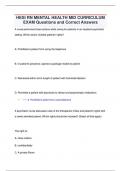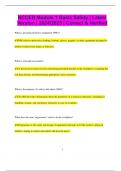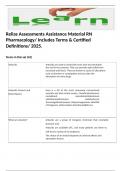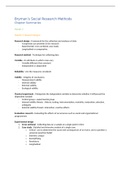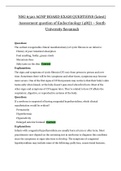Corporate Culture Management – Y2Q2
Module topics.
Egalitarian corporate culture
Hierarchical corporate culture
Person oriented corporate culture
Task oriented corporate culture
Linear active, multi-active, and reactive culture.
Communicating inegatively feedback
Planning: identifying and selecting appropriate goals and courses of action; one of the four
principal tasks of management.
Strategy: a cluster of decisions about what goals to pursue, what actions to take, and how
to use resources to achieve goals.
Contingency Theory:
Financial strategy = deals with the financial challenges of the company. This often
involves:
- Your funding objectives and how these relate to your mission.
- Your income aims for the next three to five years, including your ideal income mix
for the next three to five years.
- Where you hope to increase or decrease income,
for example “we want to increase our traded
income 25% over the next three years”.
Five types of marketing strategies:
- Product leadership
- Cost leadership / operational excellence.
- Customer intimacy.
- Experience.
- Community building.
Steps in planning:
Ia. Where are we now?
Mission = the essential
,purpose of the organization, concerning particularly why it is in existence, the mature of
the business it is in and the customers it seeks to serve and satisfy.
- Who are we / what do we do / who are our customers / what are our values?
- Focusses on the present.
Ib. Where do we want to go?
Vision = a powerful message that tells people how you view the future of your business.
- Where are we going as an organization?
- What do we want to achieve?
- What is unique and important?
II. What to do: organizational strategy.
- The mission and vision are translated
into goals.
- Strategy is a cluster of related
managerial decisions and actions to help
an organization to attain these goals.
III. How? Implementation requires change.
- Putting strategy into action.
- Allocating responsibilities.
- Detailed action plans.
- Timetable including SMART goals.
- Allocating resources.
- Holding responsibilities accountable.
McKinsey’s 7S model:
- Strategy is closely linked to other element of the organizations.
- 7S addresses the critical role of coordination, rather than
structure, in organizational effectiveness.
Why planning is important:
1. Planning is necessary to give the organization a sense of
direction and purpose.
2. Planning is a useful way of getting managers to participate in decision making
about the appropriate goals and strategies for an organization.
3. A plan helps coordinate managers of the different functions and divisions of an
organization to ensure that they all pull in the same direction and work to achieve
its desired future state.
4. A plan can be used as a device for controlling managers within an organization.
Strategic leadership: the ability of the CEO and top managers to convey a compelling
vision of what they want the organization to achieve to their subordinates.
Strategy formulating: the development of a set of corporate-, business-, and functional-
level strategies that allow an organization to accomplish its mission and achieve its goals.
, Levels of planning at general electric:
Levels and types of planning:
Corporate-level plan: top management’s
decisions pertaining to the organization’s
mission, overall strategy, and structure.
Corporate-level strategy: a plan that
indicates in which industries and national
markets an organization intends to
compete.
Business –level plan: divisional
manager’s decisions pertaining to
divisions’ long-term goals, overall
strategy, and structure.
Business-level strategy: a plan that
indicates how a division intends to
compete against its rivals in an
industry.
Functional-level plan: Functional
manager’s decisions pertaining to
the goals that they propose to
pursue to help the division attain
its business-level goals.
Functional-level strategy: a plan of
action to improve the ability of
each of an organization’s functions
to perform its task-specific
activities in ways that add value to
an organization’s goods and
services.
Organization change strategy to deal with the challenges of external adaption and internal
integration. It often involves changes in:
- Organizational structure.
- Systems.
- Staff and skills.
- Culture and shared values.
- Leadership and management.
Time horizon: the intended duration of a plan.
Corporate-level strategy:
A plan of action to manage the growth and development of an
organization so as to maximize its long-run ability to create value.
SWOT analysis:
Business-level strategy:
a planning exercise to identify
A plan of action to take advantage of favourable opportunities and
strengths and weaknesses
find ways to counter threats so as to compete effectively in an
inside an organization and
industry.
opportunities and threats in the
environment.
Functional-level strategy:
a plan of action to improve the ability of an organization’s
departments to create value.
Module topics.
Egalitarian corporate culture
Hierarchical corporate culture
Person oriented corporate culture
Task oriented corporate culture
Linear active, multi-active, and reactive culture.
Communicating inegatively feedback
Planning: identifying and selecting appropriate goals and courses of action; one of the four
principal tasks of management.
Strategy: a cluster of decisions about what goals to pursue, what actions to take, and how
to use resources to achieve goals.
Contingency Theory:
Financial strategy = deals with the financial challenges of the company. This often
involves:
- Your funding objectives and how these relate to your mission.
- Your income aims for the next three to five years, including your ideal income mix
for the next three to five years.
- Where you hope to increase or decrease income,
for example “we want to increase our traded
income 25% over the next three years”.
Five types of marketing strategies:
- Product leadership
- Cost leadership / operational excellence.
- Customer intimacy.
- Experience.
- Community building.
Steps in planning:
Ia. Where are we now?
Mission = the essential
,purpose of the organization, concerning particularly why it is in existence, the mature of
the business it is in and the customers it seeks to serve and satisfy.
- Who are we / what do we do / who are our customers / what are our values?
- Focusses on the present.
Ib. Where do we want to go?
Vision = a powerful message that tells people how you view the future of your business.
- Where are we going as an organization?
- What do we want to achieve?
- What is unique and important?
II. What to do: organizational strategy.
- The mission and vision are translated
into goals.
- Strategy is a cluster of related
managerial decisions and actions to help
an organization to attain these goals.
III. How? Implementation requires change.
- Putting strategy into action.
- Allocating responsibilities.
- Detailed action plans.
- Timetable including SMART goals.
- Allocating resources.
- Holding responsibilities accountable.
McKinsey’s 7S model:
- Strategy is closely linked to other element of the organizations.
- 7S addresses the critical role of coordination, rather than
structure, in organizational effectiveness.
Why planning is important:
1. Planning is necessary to give the organization a sense of
direction and purpose.
2. Planning is a useful way of getting managers to participate in decision making
about the appropriate goals and strategies for an organization.
3. A plan helps coordinate managers of the different functions and divisions of an
organization to ensure that they all pull in the same direction and work to achieve
its desired future state.
4. A plan can be used as a device for controlling managers within an organization.
Strategic leadership: the ability of the CEO and top managers to convey a compelling
vision of what they want the organization to achieve to their subordinates.
Strategy formulating: the development of a set of corporate-, business-, and functional-
level strategies that allow an organization to accomplish its mission and achieve its goals.
, Levels of planning at general electric:
Levels and types of planning:
Corporate-level plan: top management’s
decisions pertaining to the organization’s
mission, overall strategy, and structure.
Corporate-level strategy: a plan that
indicates in which industries and national
markets an organization intends to
compete.
Business –level plan: divisional
manager’s decisions pertaining to
divisions’ long-term goals, overall
strategy, and structure.
Business-level strategy: a plan that
indicates how a division intends to
compete against its rivals in an
industry.
Functional-level plan: Functional
manager’s decisions pertaining to
the goals that they propose to
pursue to help the division attain
its business-level goals.
Functional-level strategy: a plan of
action to improve the ability of
each of an organization’s functions
to perform its task-specific
activities in ways that add value to
an organization’s goods and
services.
Organization change strategy to deal with the challenges of external adaption and internal
integration. It often involves changes in:
- Organizational structure.
- Systems.
- Staff and skills.
- Culture and shared values.
- Leadership and management.
Time horizon: the intended duration of a plan.
Corporate-level strategy:
A plan of action to manage the growth and development of an
organization so as to maximize its long-run ability to create value.
SWOT analysis:
Business-level strategy:
a planning exercise to identify
A plan of action to take advantage of favourable opportunities and
strengths and weaknesses
find ways to counter threats so as to compete effectively in an
inside an organization and
industry.
opportunities and threats in the
environment.
Functional-level strategy:
a plan of action to improve the ability of an organization’s
departments to create value.




